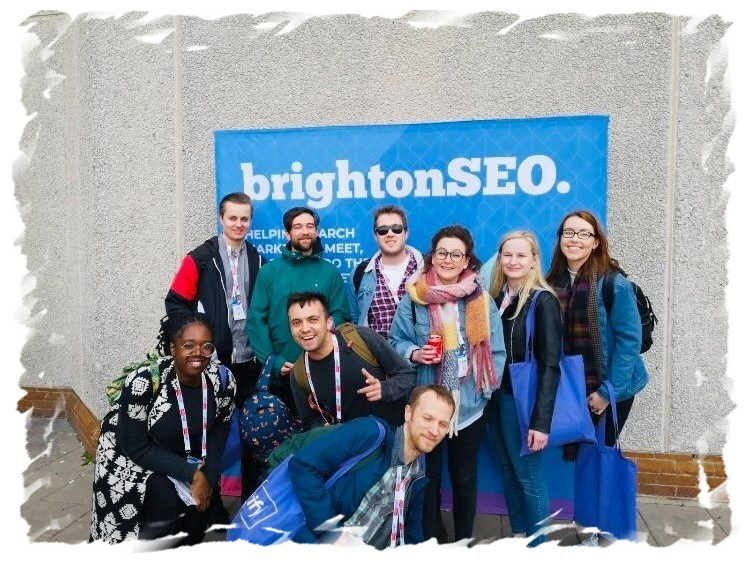
A week has now passed since BrightonSEO. It took grit, determination, and some furious typing early this week, but we managed to cover all (yes, all) of the talks. Now the dust has settled, we’ve put our heads together and collated the top 25 things that we learned by attending every talk from the conference. From perception speed to measuring voice performance, here’s what you need to know.
SERP positioning can be misleading: focus on visual prominence
The numerical SERP position isn’t always representative of how prominent a result is on a page. It’s the visual impact that matters, so always look to real-world page placement above context-free metrics.
Read more in our roundup blog, Driving *Meaningful* Clicks With Enriched SERPs.
First Meaningful Paint in Google Lighthouse is very telling
Google Lighthouse uses an audit called First Meaningful Paint, which tracks the point after the main above-the-fold change is finished and the fonts are in place. Isolated loading times don’t tell you enough: you need to dig deeper to understand the user experience.
Read more in our roundup blog, Huge SEO Success Stories & What We Can Learn From Them.
Google has an internal emergency procedure titled “OMG”
A relaxed start gave the impression that the keynote session might pass fairly uneventfully, but a whiplash-inducing change in tone made it clear that Hannah Smith wanted some meaningful answers and wasn’t going to accept anything less. In addition to finding out this amusing revelation above, Hannah asked about vital matters such as rich results depriving webmasters of clicks and Google lacking promptness in updating SEOs about no longer using rel=”next” and rel=”prev”.
Read more in our roundup blog, Keynote Q&A Session – John Mueller.
Use explainer pages over 301 redirects
Instead of 301 redirecting your old discontinued product pages, squeeze more value from them — and drive conversions — by creating a unique landing page that lists relevant alternate products.
Read more in our roundup blog, Sexy AF SEO Revenue Growth With Your Discontinued Products.
Use perception speed to impress users
Use perception speed to improve UX (and keep users on-site) while the rest of your page loads in the background. This is where above the fold content loads before any other on-page content so the user believes they are looking at a fully loaded web page.
Read more in our roundup blog, Speed & Performance Optimisation: How to Meet Users’ High Expectations.
Link origin will get more significant
John Warner has something he calls a conspiracy theory: that Google is preparing (both legally and technologically) to pass the development of its ranking algorithm to a machine learning process. This will fundamentally change how SEOs need to work, forcing them to look past DA and focus on relevance.
Read more in our roundup blog, Why Google Isn’t Giving Update Advice Anymore.
Don’t silo your PPC data — integrate it with your data channels
Rather than using disparate sets of data from your PPC strategy for different search engines, they can be combined to provide rich information to implement real-world actions. PPC data can (and should) be cascaded across the rest of your business; for example, by helping you spot areas where there is high demand for your product but no brick-and-mortar stores to serve it.
Read more in our roundup blog, Using Data Science To Work Smarter, Not Harder In PPC.
SEO is a science (not an art), so be forensic
As a science, for SEO to achieve deliverable, repeatable, and sensible results, you need a firm understanding of the environment you’re operating in. This means thinking like a business owner and understanding the constraints (such as AOV and profit margins) that you’re operating with.
Read more in our roundup blog, Predicting The Impact Of Technical SEO Changes.
Get to the point in your outreach email
Emails are one of the main ways of getting in touch with the press when it comes to pitching content and assets — and getting ignored in someone’s inbox can lead to a failed campaign, and wasted time and resources. Journos and publications are often time-poor, so tell them what you’re offering in the first paragraph.
Read more in our roundup blog, The Killer Outreach Email That Gets Opened, Replied To And Mainly Gains Links.
Paginated pages are indexed separately – give them unique elements
Once upon a time, Google used rel next to consolidate a series of pages to one main page. But that’s in the past and Google no longer looks at those elements. Instead, paginated pages are now indexed separately, meaning that they need unique content, URLs and more.
Read more in our roundup blog, The State Of Pagination And Infinite Scroll On The Web.
For video marketing, set your Google Alerts
If vloggers have not transcribed their videos, get a content writer to do so. The influencer can then be contacted with the link to your transcription which they will often put on their blog.
Read more in our roundup blog, 10 Tips To Scale Link Building.
Google uses structured data to understand content better, so add it
New Schema.org markup options are in the pipeline, and every type of markup has the potential to be embraced and used by Google. Companies that commit to optimising their websites for search crawlers will have many more opportunities to appear prominently in results.
Read more in our roundup blog, Make Your Website Stand Out In Search.
Make sure Google steals the right data.
Much has been made of Google’s rich results taking clicks away from webmasters, but they can’t shoulder all the blame. Plenty of it can be attributed to webmasters failing to satisfy searcher intent. If you bring in the right kind of traffic, and serve it well, you can still thrive. They’re going to do it anyway, so use rich data to make sure Google steals the right data.
Read more in our roundup blog, Driving *Meaningful* Clicks With Enriched SERPs.
Branded search results are a vital touchpoint for any business
Everyone uses branded search: customers/clients, potential employees, investors, journalists and legislators are just some of the people searching for your brand for a whole range of reasons. This makes branded search one of the most powerful elements of SEO.
Read more in our roundup blog, How To Protect Your Online Reputation: Lessons From The Ftse 100.
Instead of fighting rendering budget, help Google by optimising JavaScript
Google has trouble with rendering. Anything you can do to help will be rewarded. For this reason, the best thing you can do as an SEO is to sit down with your dev team and discuss what is possible for your website.
Read more in our roundup blog, Crawl Budget Is Dead.
Tell a story around your data to help the client understand your point
It’s not uncommon for clients to struggle to grasp technical SEO language and data. To combat this, it’s important for SEOs to create a story around the data to help the client related and understand the issue. Screaming Frog has a built-in visualisation tool which is perfect for beginners.
Read more in our roundup blog, Ways To Visualise Your Crawl Data.
It’s a good idea to think about search intent while optimising
We all know that search engines love content and that inspires SEOs to create as much of it as possible. However, while the temptation is to create brand new copy, one of the best ways you can boost your ranking is to optimise the existing content on your website. Thinking about the four types of searcher intent — informational, transactional, navigational, and quick knowledge — will help you make the most of your optimisation efforts.
Read more in our roundup blog, Building an SEO Exponential Growth model by Closing Your Content Gaps.
To create your brand voice, you must first look at your current voice
Brand voice is a phrase often bandied about but rarely delved into. It’s about how you communicate, the way you do it, how it conveys your brand personality, how it should reflect who your audience is, and why consistency matter. Brand voice is what helps your SEO efforts pay off.
Read more in our roundup blog, Standing Out Online With A Unique And Compelling Brand Voice.
Make your anchors less time-sensitive
To get the max from your internal links you should change branded phrases to money phrases (generic terms people actually search for). You must also make your internal link anchor text less time-sensitive. Adopting this strategy is not only a proven way of improving your rankings, but it’s also one of the most time-efficient SEO tactics.
Read more in our roundup blog, Improve Your Rankings With Internal Link Building, And No Headaches.
Podcasting can earn subscribers, mentions, and really big links
Podcasts are soaring in popularity (especially among young people), and they provide a vital channel for brands to connect with consumers. It’s important that this profitable channel does not go untapped, so you can go straight to your customers’ ears and grow your brand.
Read more in our roundup blog, Podcasting For Subscribers, Mentions And Really Big Links.
Don’t bother trying to measure voice search performance
The SEO industry has a habit of getting distracted by shiny objects, and, for many, voice search is the shiniest object around at the moment. In truth, most people don’t use voice search much at all — they use voice command to play music, store notes, etc. There isn’t much reason to focus on voice search. Success is unclear, and other improvements matter more.
Read more in our roundup blog, Forget Alexa, The Voice Search Devices Of The Future.
Machine learning can free time for human-only outreach tasks
Combining the benefits of machine learning with human-in-the-loop interactions can boost your outreach efforts. By using the bots to do the heavy lifting (without sacrificing the human elements of outreach) it’s simple to increase efficiency, have more conversations with the right people and win more links.
Read more in our roundup blog, LMFAO: Leveraging Machines for Awesome Outreach.
Metadata optimisation can have very fast results
A quote from Chris Liversidge, Director at QueryClick Ltd, “On enterprise-level sites, it’s fast, drives clicks, don’t need to think about ranking changes, gets you into a positive feedback loop. If you’re in the top positions with a worse-than-expected click-through rate, you’re gonna get dropped back out, and the flipside is true.”
Read more in our roundup blog, How To Drive SEO Impact In Google’s Linkless Algorithm.
Leveraging E-A-T will be key to SEO success
Standing for expertise, authority, and trustworthiness, E-A-T is an acronym that is referred to a lot in Google’s Quality Raters’ Guidelines. After the Google E-A-T Algorithm updated in August 2018, a lot of websites that didn’t meet the required standard for quality experienced a huge drop in traffic. Moving forward, improving your online reputation with reviews from third-party sites, citing credible sourced, clarifying authorship, and making sure your money or our life (YMYL) content is backed up by scientific evidence will be crucial to SEO success.
Read more in our roundup blog, Leveraging E-A-T for SEO Success.
In blind tests users preferred Bing over Google
As we all know, Google keeps making life harder for SEOs, squeezing websites out of the SERPs and replacing them with featured snippets. Bing is also investing in rich results, but largely doing them better. What’s more, with a lower market share, Bing has less negotiating power, and could have a stronger relationship with the SEO community than Google has. Wouldn’t we all benefit from having two viable engines instead of just one?
Read more in our roundup blog, Why We All Should Stop Ignoring Bing.
So there you have it: The top 25 things we learned from BrightonSEO. Seeker loves attending the conference, and many of the things covered here, we will be incorporating into our own work and for our clients. See you again in six months time!
